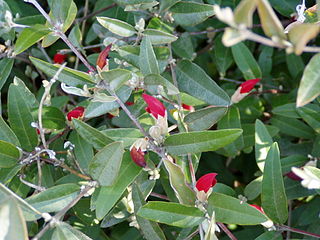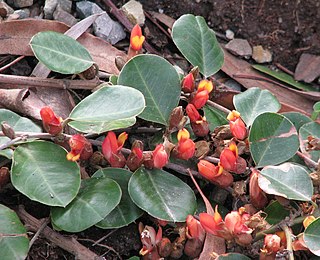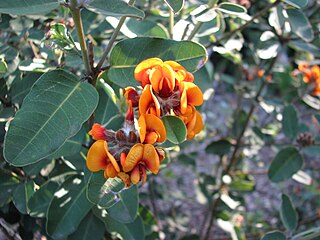
Gastrolobium is a genus of flowering plants in the family Fabaceae. There are over 100 species in this genus, and all but two are native to the south west region of Western Australia.

Gastrolobium melanopetalum is a shrub in the family Fabaceae which is endemic to the south-west of Western Australia.

Gastrolobium praemorsum is a scrambling shrub which is endemic to the south-west of Western Australia. It is a member of the family Fabaceae and produces red pea-flowers from late winter to early summer. It is not known whether this species shares the toxic properties of many other members of the genus Gastrolobium.

Gastrolobium bilobum, commonly known as heart-leaved poison, is a bushy shrub which is endemic to south west Western Australia.

Gastrolobium celsianum, the Swan River pea, is a low-growing shrub which is endemic to Western Australia.

Daviesia, commonly known as bitter-peas, is a genus of about 130 species of flowering plants in the family Fabaceae, and is endemic to Australia. Plants in the genus Daviesia are shrubs or small trees with leaves modified as phyllodes or reduced to scales. The flowers are arranged singly or in groups, usually in leaf axils, the sepals joined at the base with five teeth, the petals usually yellowish with reddish markings and the fruit a pod.

Gastrolobium sericeum is a flowering plant in the family Fabaceae. It is endemic to the south-west of Western Australia. It is a prostrate, low shrub with pendulous yellow, green, red or nearly black pea-flowers from spring to summer.

Gastrolobium grandiflorum, commonly known as wallflower poison, wallflower poison bush or heart-leaf poison bush, is a bushy shrub which is endemic to Australia.

Gastrolobium spinosum, also known as prickly poison, is a shrub in the family Fabaceae. It is endemic to Southwest Australia

Gastrolobium minus, also known as broad-leaved brachysema, is a prostrate shrub which is endemic to the south-west of Western Australia. It is a member of the family Fabaceae and of the genus Gastrolobium, which contains many toxic species, however the toxicity of this species is unknown.

Gastrolobium coriaceum is a shrub species in the family Fabaceae. It is endemic to the south west of Western Australia.

Jacksonia lehmannii is a species of leafless broom-like shrub or small tree in the family Fabaceae that is native to the south west of Western Australia. It was first described by Carl Meissner in 1844. It has no synonyms.

Daviesia hakeoides is a species of flowering plant in the family Fabaceae and is endemic to the south-west of Western Australia. It is a shrub with many tangled stems, scattered sharply-pointed phyllodes and yellow or orange and dark red flowers.

Gastrolobium formosum is a small, trailing shrub, with red flowers, in the pea family (Fabaceae), which grows up to a metre high, on clays and loam in swamps and along river banks. The inflorescence consists of head of four unstalked flowers which is sheathed by a whorl of large bracts, with the flower petals being obscured by the lower calyx lobes. The standard petal is less than on third the keel petal. It is native to the south-west of Western Australia.

Gastrolobium nervosum is a small shrub in the pea family (Fabaceae), native to Western Australia.

Gastrolobium rigidum is a small bushy shrub in the pea family (Fabaceae), native to Western Australia.

Gastrolobium villosum is a low spreading shrub in the pea family (Fabaceae), native to Western Australia. Like most Gastrolobiums it is poisonous to stock.

Daviesia decurrens, commonly known as prickly bitter-pea, is a species of flowering plant in the family Fabaceae and is endemic to the south-west of Western Australia. It is spreading, erect, or low-lying shrub with scattered, sharply-pointed, narrow triangular phyllodes, and yellowish pink and velvety red flowers.

Daviesia elongata is a species of flowering plant in the family Fabaceae and is endemic to the south-west of Western Australia. It is a glabrous, spreading or sprawling shrub with narrowly egg-shaped to linear phyllodes and yellow-orange and maroon flowers.
Daviesia microcarpa, commonly known as Norseman pea, is a species of flowering plant in the family Fabaceae and is endemic to two small areas of inland Western Australia. It is a sprawling shrub with tangled stems and crowded, needle-shaped, sharply-pointed phyllodes, and orange and pinkish-red flowers.




















